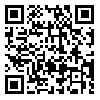Volume 2, Issue 3 (2022)
2022, 2(3): 43-57 |
Back to browse issues page
Download citation:
BibTeX | RIS | EndNote | Medlars | ProCite | Reference Manager | RefWorks
Send citation to:



BibTeX | RIS | EndNote | Medlars | ProCite | Reference Manager | RefWorks
Send citation to:
Farzad Behtash M R, Ertefaei F. Introducing Three New Approaches to Urban Runoff Management in Order to Replace Creative Methods with the Goal of Solving Related Problems in Urban Spaces. Urban Design Discourse a Review of Contemporary Litreatures and Theories 2022; 2 (3) :43-57
URL: http://udd.modares.ac.ir/article-40-56113-en.html
URL: http://udd.modares.ac.ir/article-40-56113-en.html
1- Assistant Professor, Department of Urban Planning, Faculty of Engineering, Azad University, North Tehran Branch, Tehran, Iran, Farzad.behtash@gmail.com. , farzad.behtash@gmail.com
2- PhD Candidate, Department of Urban Planning, Faculty of Engineering, Azad University, North Tehran Branch, Tehran, Iran, Farbod_fe@yahoo.com.
2- PhD Candidate, Department of Urban Planning, Faculty of Engineering, Azad University, North Tehran Branch, Tehran, Iran, Farbod_fe@yahoo.com.
Abstract: (2467 Views)
Introduction: In the present century, with the expansion of urbanization and urban development, impermeable surfaces (asphalt, concrete) have also increased and these changes have caused runoff to flow in the city and consequently problems such as traffic disruption, pollution of receiving waters, Reduce groundwater levels and the formation of floods. Traditional methods are not very effective today and in some cases even exacerbate these problems. Therefore, the need for new and creative methods to manage runoff is felt more than ever.
Findings: Three approaches including: water-sensitive urban design, low impact development and sustainable urban drainage systems are among these new approaches that are based on sustainability principles and have multiple benefits (maintaining environmental conditions and completing the urban water cycle) in addition to runoff management.
Method: In terms of purpose, this research is fundamental and from the point of view of analysis method, it is considered as one of the theoretical researches in which by using internet resources and library documents, an attempt is made to identify the concepts, goals and benefits of these three approaches.
Conclusion: Finally by extracting common goals, the success rate of achieving each goal is determined by using the utility matrix, and in addition to formulating a conceptual model of sustainable runoff management, a table of strategies for achieving this approach has been provided.
Findings: Three approaches including: water-sensitive urban design, low impact development and sustainable urban drainage systems are among these new approaches that are based on sustainability principles and have multiple benefits (maintaining environmental conditions and completing the urban water cycle) in addition to runoff management.
Method: In terms of purpose, this research is fundamental and from the point of view of analysis method, it is considered as one of the theoretical researches in which by using internet resources and library documents, an attempt is made to identify the concepts, goals and benefits of these three approaches.
Conclusion: Finally by extracting common goals, the success rate of achieving each goal is determined by using the utility matrix, and in addition to formulating a conceptual model of sustainable runoff management, a table of strategies for achieving this approach has been provided.
Keywords: Water Sensitive Urban Design, Low Impact development, Sustainable Urban Drainage Systems, Urban Runoff Management.
Article Type: Original Research |
Subject:
Urban Design Theories
Received: 2021/10/5 | Accepted: 2022/01/18 | Published: 2022/01/30
Received: 2021/10/5 | Accepted: 2022/01/18 | Published: 2022/01/30
Send email to the article author
| Rights and permissions | |
 |
This work is licensed under a Creative Commons Attribution-NonCommercial 4.0 International License. |







